Ziyong Feng
ProCLIP: Progressive Vision-Language Alignment via LLM-based Embedder
Oct 22, 2025Abstract:The original CLIP text encoder is limited by a maximum input length of 77 tokens, which hampers its ability to effectively process long texts and perform fine-grained semantic understanding. In addition, the CLIP text encoder lacks support for multilingual inputs. All these limitations significantly restrict its applicability across a broader range of tasks. Recent studies have attempted to replace the CLIP text encoder with an LLM-based embedder to enhance its ability in processing long texts, multilingual understanding, and fine-grained semantic comprehension. However, because the representation spaces of LLMs and the vision-language space of CLIP are pretrained independently without alignment priors, direct alignment using contrastive learning can disrupt the intrinsic vision-language alignment in the CLIP image encoder, leading to an underutilization of the knowledge acquired during pre-training. To address this challenge, we propose ProCLIP, a curriculum learning-based progressive vision-language alignment framework to effectively align the CLIP image encoder with an LLM-based embedder. Specifically, ProCLIP first distills knowledge from CLIP's text encoder into the LLM-based embedder to leverage CLIP's rich pretrained knowledge while establishing initial alignment between the LLM embedder and CLIP image encoder. Subsequently, ProCLIP further aligns the CLIP image encoder with the LLM-based embedder through image-text contrastive tuning, employing self-distillation regularization to avoid overfitting. To achieve a more effective alignment, instance semantic alignment loss and embedding structure alignment loss are employed during representation inheritance and contrastive tuning. The Code is available at https://github.com/VisionXLab/ProCLIP.
UniVerse: Unleashing the Scene Prior of Video Diffusion Models for Robust Radiance Field Reconstruction
Oct 02, 2025


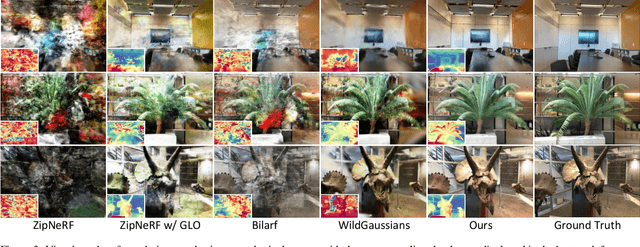
Abstract:This paper tackles the challenge of robust reconstruction, i.e., the task of reconstructing a 3D scene from a set of inconsistent multi-view images. Some recent works have attempted to simultaneously remove image inconsistencies and perform reconstruction by integrating image degradation modeling into neural 3D scene representations.However, these methods rely heavily on dense observations for robustly optimizing model parameters.To address this issue, we propose to decouple robust reconstruction into two subtasks: restoration and reconstruction, which naturally simplifies the optimization process.To this end, we introduce UniVerse, a unified framework for robust reconstruction based on a video diffusion model. Specifically, UniVerse first converts inconsistent images into initial videos, then uses a specially designed video diffusion model to restore them into consistent images, and finally reconstructs the 3D scenes from these restored images.Compared with case-by-case per-view degradation modeling, the diffusion model learns a general scene prior from large-scale data, making it applicable to diverse image inconsistencies.Extensive experiments on both synthetic and real-world datasets demonstrate the strong generalization capability and superior performance of our method in robust reconstruction. Moreover, UniVerse can control the style of the reconstructed 3D scene. Project page: https://jin-cao-tma.github.io/UniVerse.github.io/
Gradient-Attention Guided Dual-Masking Synergetic Framework for Robust Text-based Person Retrieval
Sep 11, 2025Abstract:Although Contrastive Language-Image Pre-training (CLIP) exhibits strong performance across diverse vision tasks, its application to person representation learning faces two critical challenges: (i) the scarcity of large-scale annotated vision-language data focused on person-centric images, and (ii) the inherent limitations of global contrastive learning, which struggles to maintain discriminative local features crucial for fine-grained matching while remaining vulnerable to noisy text tokens. This work advances CLIP for person representation learning through synergistic improvements in data curation and model architecture. First, we develop a noise-resistant data construction pipeline that leverages the in-context learning capabilities of MLLMs to automatically filter and caption web-sourced images. This yields WebPerson, a large-scale dataset of 5M high-quality person-centric image-text pairs. Second, we introduce the GA-DMS (Gradient-Attention Guided Dual-Masking Synergetic) framework, which improves cross-modal alignment by adaptively masking noisy textual tokens based on the gradient-attention similarity score. Additionally, we incorporate masked token prediction objectives that compel the model to predict informative text tokens, enhancing fine-grained semantic representation learning. Extensive experiments show that GA-DMS achieves state-of-the-art performance across multiple benchmarks.
Region-based Cluster Discrimination for Visual Representation Learning
Jul 26, 2025Abstract:Learning visual representations is foundational for a broad spectrum of downstream tasks. Although recent vision-language contrastive models, such as CLIP and SigLIP, have achieved impressive zero-shot performance via large-scale vision-language alignment, their reliance on global representations constrains their effectiveness for dense prediction tasks, such as grounding, OCR, and segmentation. To address this gap, we introduce Region-Aware Cluster Discrimination (RICE), a novel method that enhances region-level visual and OCR capabilities. We first construct a billion-scale candidate region dataset and propose a Region Transformer layer to extract rich regional semantics. We further design a unified region cluster discrimination loss that jointly supports object and OCR learning within a single classification framework, enabling efficient and scalable distributed training on large-scale data. Extensive experiments show that RICE consistently outperforms previous methods on tasks, including segmentation, dense detection, and visual perception for Multimodal Large Language Models (MLLMs). The pre-trained models have been released at https://github.com/deepglint/MVT.
Breaking the Modality Barrier: Universal Embedding Learning with Multimodal LLMs
Apr 24, 2025Abstract:The Contrastive Language-Image Pre-training (CLIP) framework has become a widely used approach for multimodal representation learning, particularly in image-text retrieval and clustering. However, its efficacy is constrained by three key limitations: (1) text token truncation, (2) isolated image-text encoding, and (3) deficient compositionality due to bag-of-words behavior. While recent Multimodal Large Language Models (MLLMs) have demonstrated significant advances in generalized vision-language understanding, their potential for learning transferable multimodal representations remains underexplored.In this work, we present UniME (Universal Multimodal Embedding), a novel two-stage framework that leverages MLLMs to learn discriminative representations for diverse downstream tasks. In the first stage, we perform textual discriminative knowledge distillation from a powerful LLM-based teacher model to enhance the embedding capability of the MLLM\'s language component. In the second stage, we introduce hard negative enhanced instruction tuning to further advance discriminative representation learning. Specifically, we initially mitigate false negative contamination and then sample multiple hard negatives per instance within each batch, forcing the model to focus on challenging samples. This approach not only improves discriminative power but also enhances instruction-following ability in downstream tasks. We conduct extensive experiments on the MMEB benchmark and multiple retrieval tasks, including short and long caption retrieval and compositional retrieval. Results demonstrate that UniME achieves consistent performance improvement across all tasks, exhibiting superior discriminative and compositional capabilities.
Decoupled Global-Local Alignment for Improving Compositional Understanding
Apr 23, 2025Abstract:Contrastive Language-Image Pre-training (CLIP) has achieved success on multiple downstream tasks by aligning image and text modalities. However, the nature of global contrastive learning limits CLIP's ability to comprehend compositional concepts, such as relations and attributes. Although recent studies employ global hard negative samples to improve compositional understanding, these methods significantly compromise the model's inherent general capabilities by forcibly distancing textual negative samples from images in the embedding space. To overcome this limitation, we introduce a Decoupled Global-Local Alignment (DeGLA) framework that improves compositional understanding while substantially mitigating losses in general capabilities. To optimize the retention of the model's inherent capabilities, we incorporate a self-distillation mechanism within the global alignment process, aligning the learnable image-text encoder with a frozen teacher model derived from an exponential moving average. Under the constraint of self-distillation, it effectively mitigates the catastrophic forgetting of pretrained knowledge during fine-tuning. To improve compositional understanding, we first leverage the in-context learning capability of Large Language Models (LLMs) to construct about 2M high-quality negative captions across five types. Subsequently, we propose the Image-Grounded Contrast (IGC) loss and Text-Grounded Contrast (TGC) loss to enhance vision-language compositionally. Extensive experimental results demonstrate the effectiveness of the DeGLA framework. Compared to previous state-of-the-art methods, DeGLA achieves an average enhancement of 3.5% across the VALSE, SugarCrepe, and ARO benchmarks. Concurrently, it obtains an average performance improvement of 13.0% on zero-shot classification tasks across eleven datasets. Our code will be released at https://github.com/xiaoxing2001/DeGLA
MotionStreamer: Streaming Motion Generation via Diffusion-based Autoregressive Model in Causal Latent Space
Mar 19, 2025Abstract:This paper addresses the challenge of text-conditioned streaming motion generation, which requires us to predict the next-step human pose based on variable-length historical motions and incoming texts. Existing methods struggle to achieve streaming motion generation, e.g., diffusion models are constrained by pre-defined motion lengths, while GPT-based methods suffer from delayed response and error accumulation problem due to discretized non-causal tokenization. To solve these problems, we propose MotionStreamer, a novel framework that incorporates a continuous causal latent space into a probabilistic autoregressive model. The continuous latents mitigate information loss caused by discretization and effectively reduce error accumulation during long-term autoregressive generation. In addition, by establishing temporal causal dependencies between current and historical motion latents, our model fully utilizes the available information to achieve accurate online motion decoding. Experiments show that our method outperforms existing approaches while offering more applications, including multi-round generation, long-term generation, and dynamic motion composition. Project Page: https://zju3dv.github.io/MotionStreamer/
Mocap-2-to-3: Lifting 2D Diffusion-Based Pretrained Models for 3D Motion Capture
Mar 05, 2025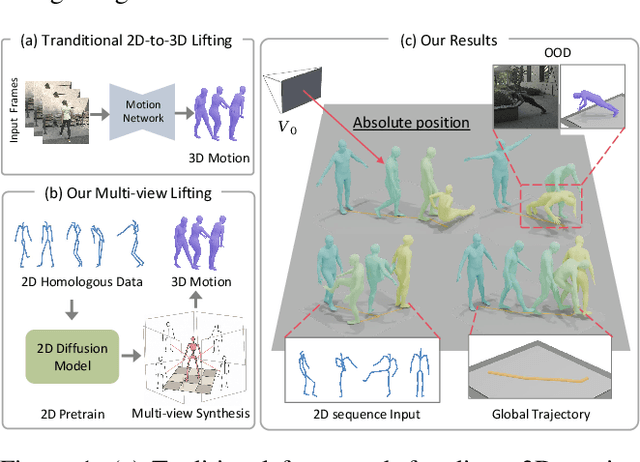

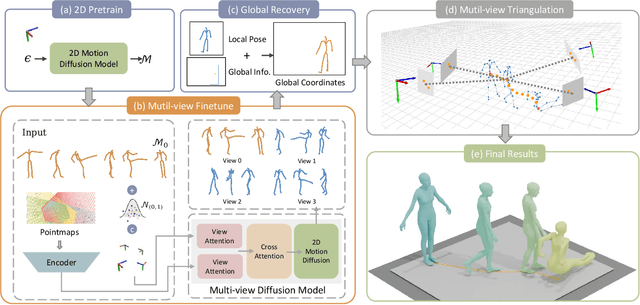
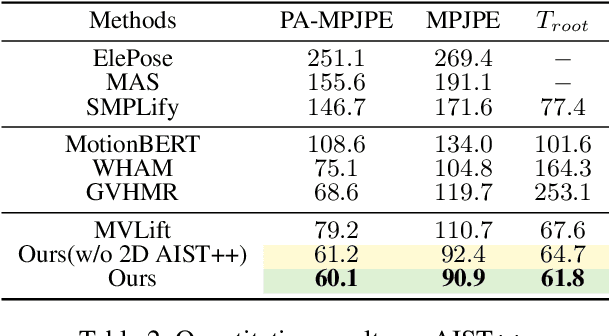
Abstract:Recovering absolute poses in the world coordinate system from monocular views presents significant challenges. Two primary issues arise in this context. Firstly, existing methods rely on 3D motion data for training, which requires collection in limited environments. Acquiring such 3D labels for new actions in a timely manner is impractical, severely restricting the model's generalization capabilities. In contrast, 2D poses are far more accessible and easier to obtain. Secondly, estimating a person's absolute position in metric space from a single viewpoint is inherently more complex. To address these challenges, we introduce Mocap-2-to-3, a novel framework that decomposes intricate 3D motions into 2D poses, leveraging 2D data to enhance 3D motion reconstruction in diverse scenarios and accurately predict absolute positions in the world coordinate system. We initially pretrain a single-view diffusion model with extensive 2D data, followed by fine-tuning a multi-view diffusion model for view consistency using publicly available 3D data. This strategy facilitates the effective use of large-scale 2D data. Additionally, we propose an innovative human motion representation that decouples local actions from global movements and encodes geometric priors of the ground, ensuring the generative model learns accurate motion priors from 2D data. During inference, this allows for the gradual recovery of global movements, resulting in more plausible positioning. We evaluate our model's performance on real-world datasets, demonstrating superior accuracy in motion and absolute human positioning compared to state-of-the-art methods, along with enhanced generalization and scalability. Our code will be made publicly available.
RealSyn: An Effective and Scalable Multimodal Interleaved Document Transformation Paradigm
Feb 18, 2025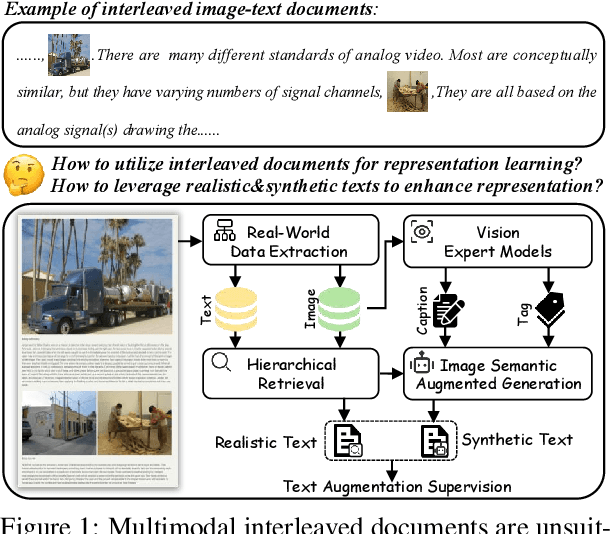

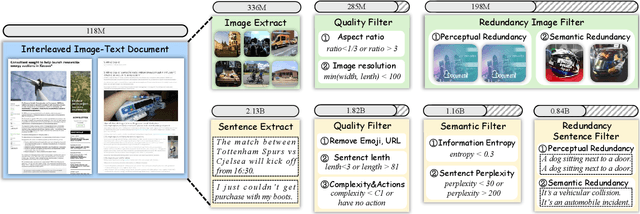

Abstract:After pre-training on extensive image-text pairs, Contrastive Language-Image Pre-training (CLIP) demonstrates promising performance on a wide variety of benchmarks. However, a substantial volume of non-paired data, such as multimodal interleaved documents, remains underutilized for vision-language representation learning. To fully leverage these unpaired documents, we initially establish a Real-World Data Extraction pipeline to extract high-quality images and texts. Then we design a hierarchical retrieval method to efficiently associate each image with multiple semantically relevant realistic texts. To further enhance fine-grained visual information, we propose an image semantic augmented generation module for synthetic text production. Furthermore, we employ a semantic balance sampling strategy to improve dataset diversity, enabling better learning of long-tail concepts. Based on these innovations, we construct RealSyn, a dataset combining realistic and synthetic texts, available in three scales: 15M, 30M, and 100M. Extensive experiments demonstrate that RealSyn effectively advances vision-language representation learning and exhibits strong scalability. Models pre-trained on RealSyn achieve state-of-the-art performance on multiple downstream tasks. To facilitate future research, the RealSyn dataset and pre-trained model weights are released at https://github.com/deepglint/RealSyn.
ORID: Organ-Regional Information Driven Framework for Radiology Report Generation
Nov 20, 2024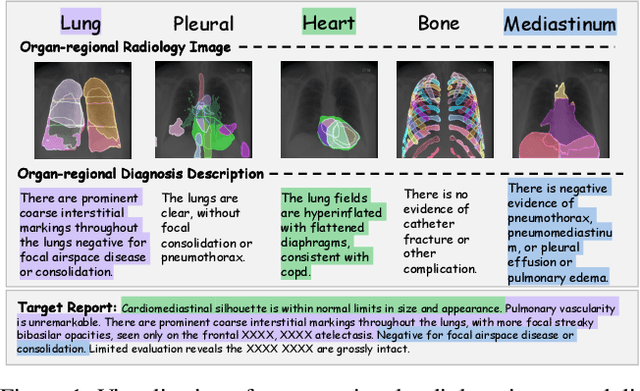
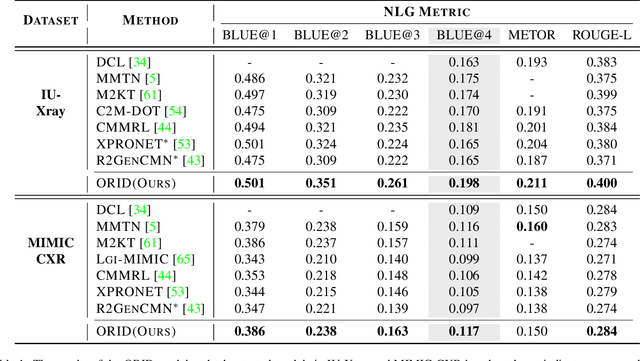
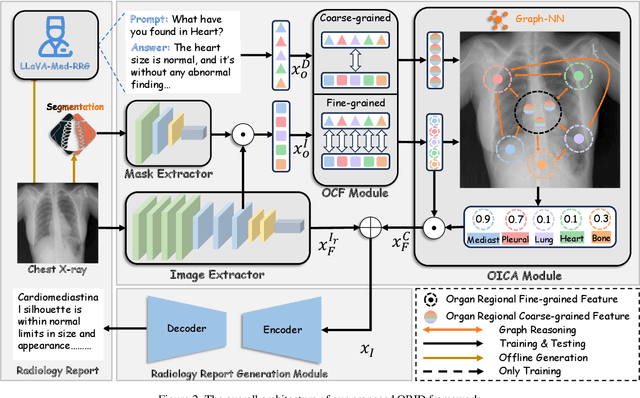
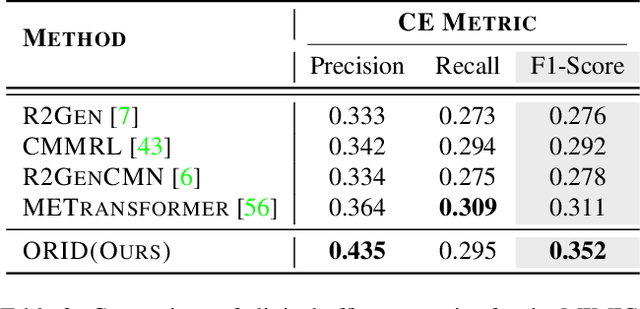
Abstract:The objective of Radiology Report Generation (RRG) is to automatically generate coherent textual analyses of diseases based on radiological images, thereby alleviating the workload of radiologists. Current AI-based methods for RRG primarily focus on modifications to the encoder-decoder model architecture. To advance these approaches, this paper introduces an Organ-Regional Information Driven (ORID) framework which can effectively integrate multi-modal information and reduce the influence of noise from unrelated organs. Specifically, based on the LLaVA-Med, we first construct an RRG-related instruction dataset to improve organ-regional diagnosis description ability and get the LLaVA-Med-RRG. After that, we propose an organ-based cross-modal fusion module to effectively combine the information from the organ-regional diagnosis description and radiology image. To further reduce the influence of noise from unrelated organs on the radiology report generation, we introduce an organ importance coefficient analysis module, which leverages Graph Neural Network (GNN) to examine the interconnections of the cross-modal information of each organ region. Extensive experiments an1d comparisons with state-of-the-art methods across various evaluation metrics demonstrate the superior performance of our proposed method.
 Add to Chrome
Add to Chrome Add to Firefox
Add to Firefox Add to Edge
Add to Edge